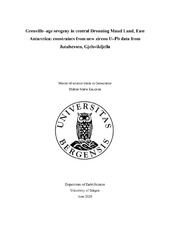| dc.description.abstract | The Mesoproterozoic Maud Belt within central Dronning Maud Land, East Antarctica, preserve important information about the tectonic setting along the eastern margin of the Kalahari Craton and is an essential key in both the Rodinia and Gondwana supercontinent. So far, limited geochronological data is covering the Grenville–age magmatic history, and more data is needed to get a better understanding of the formation of the Maud Belt. In this study, new SIMS U–Pb zircon ages are revealed from six high–grade granitoids conducted within the Jutulsessen nunataks in Gjelsvikfjella (west–central part of the Maud Belt). Five of the investigated samples report Grenville–age magmatism between ca. 1179–1061 Ma, while the remaining sample yields a Pan–African crystallization age at ca. 497 Ma. The oldest age group of ca. 1179–1131 Ma is considered to represent the initial volcanic arc magmatism forming the Maud arc, while the youngest Grenville–age of ca. 1061 Ma corresponds to a subsequent magmatic period of granitic intrusions. These data thus confirm Grenville–age magmatism in the area. Further, one potential inherited zircon core, ca. 1240 Ma, is detected from one of the Mesoproterozoic samples and may represent the involvement of older crustal components. Late Mesoproterozoic metamorphism has been recorded at ca. 1128 Ma and 1105 Ma from zircon rim overgrowths. This indicates metamorphism prior to the major metamorphic event between 1090–1030 Ma. However, the metamorphic ages do coincide with increased magmatic activity within the Maud Belt, and could thus reflect thermal imprints related to igneous emplacements during a magmatic pulse. The Mesoproterozoic basement was later intensely reworked during late Neoproterozoic–early Paleozoic times, associated with the collisional phase of Gondwana. One of the Mesoproterozoic rocks documents this event by metamorphic zircon rim overgrowths around 549 Ma. Subsequently, the central Dronning Maud Land is suggested to have experienced extensional orogenic collapse, which led metamorphic imprints and post–tectonic magmatism, here detected from two samples at ca. 496 Ma and 497 Ma, respectively. | en_US |
